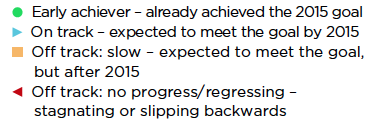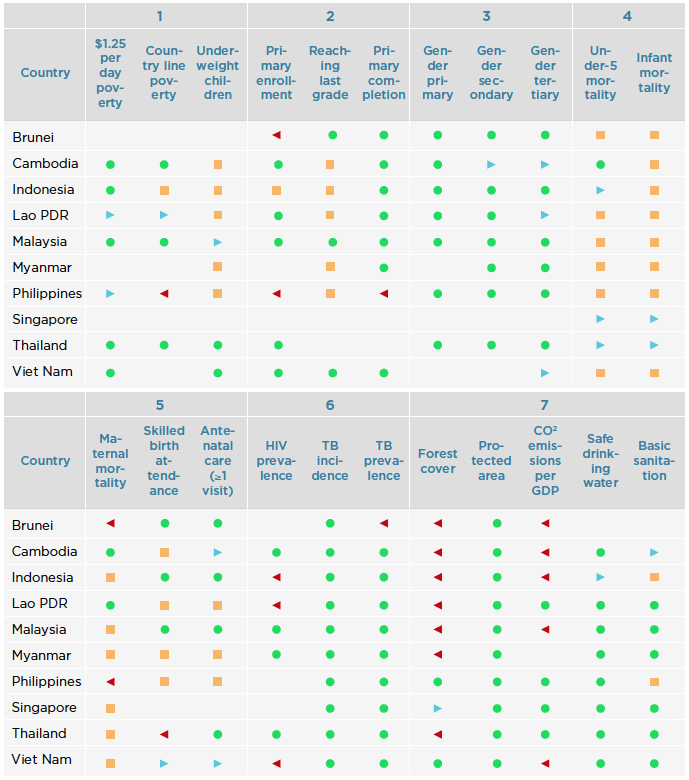AEC Blueprint 2025 Analysis: Paper 15 | An analysis of the ASEAN priorities on Sustainable Economic Development
by Dr. Bambang Irawan | Published on 17 January 2017
Summary
ASEAN is now prioritising economic development that is sustainable, which takes into consideration the sustainability of the environmental factors that are important to support it. Given the region’s bad track record when it comes to environment protection, it is only fitting that the new blueprint includes this in its agenda. The challenge is to turn all the good plans into reality to ensure that the economic activities do not have negative impacts on the environment through the use of cleaner, renewable energy and technology.
Foreword
The following report is part of a series which attempts to provide a detailed analysis on the ASEAN Economic Community (AEC) Blueprint 2025. Each report will cover a single element of the blueprint, providing a comprehensive look at past achievements, present problems, and the future plans of the AEC. Special attention will be placed upon the strategic measures outlined in the AEC Blueprint 2025. This report aims to provide insight into the viability surrounding regional economic integration under the AEC.
Sustainable Economic Development
ASEAN is now starting to prioritise sustainable development as an integral part of the AEC. The International Institute for Sustainable Development (IISD) has defined it as follows:
-
“Sustainable development is development that meets the needs of the present without compromising the ability of future generations to meet their own needs. It contains within it two key concepts:
- the concept of needs, in particular the essential needs of the world’s poor, to which overriding priority should be given; and
- the idea of limitations imposed by the state of technology and social organisation on the environment’s ability to meet present and future needs.”
It is considered very important that resources that ensure sufficient supply to the next generations are not depleted and can be renewed as much as possible. Given the recent events such as forest fires that have negative impacts to the region, it is appropriate that ASEAN member states collectively can develop strategies to sustain the pace of economic development without putting negative pressures to the environment or to the future generations. This report aims at analysing how ASEAN is planning to pursue sustainable economic development without compromising the environmental and other supporting factors.
A. Targets under the AEC 2015 Blueprint
Sustainable economic development is a new initiative that was not included in the previous blueprint. This is a new priority that is expected to guide ASEAN in ensuring that the economic activities will not have any negative repercussions on the environment and that the much needed natural resources are not severely depleted and can continue to support the realisation of the AEC.
B. Significant Achievements To Date
Given that the AEC Blueprint 2015 did not specifically outline sustainable development gap as an ASEAN priority, there were not any measured targets to be achieved by end of 2015.
However, when discussing sustainable development, our initial reference may be the Millennium Development Goals (MDGs) that were established by the Millennium Summit of the United Nations in 2000. These are eight international development goals to be achieved by the year 2015. Since 2016, the MDGs have been replaced by the Sustainable Development Goals (SDGs), which is a set of 17 global goals ranging from poverty and hunger eradication, education, climate change, and peace and justice. In September 2015, the UN General Assembly adopted the 2030 Development Agenda that is titled “Transforming our world: the 2030 Agenda for Sustainable Development.”
While the outcomes of the SDGs remain to be seen in the coming years, the following table, which is taken from the Asia-Pacific Regional MDGs Report 2014/15, provides some indication of the progress of MDGs’ implementation in ASEAN. The results could indicate how ASEAN member states have attempted to implement measures to achieve the international development goals that are consistent with sustainable development objectives. The 21 goals included here, under MDG 1 to 7, are based on trends since 1990 that have been used to evaluate whether the economic development taking place thus far have brought about (significant) changes in the lives of the people. Each indicator is measured in four different categories as follows:


The table indicates that ASEAN member states generally have done well on MDGs 1 (eradicate poverty and hunger), 3 (promote gender equality), and 6 (combat HIV, malaria and other diseases). With the exception of Thailand and Singapore, most countries have not done well to reduce child mortality rates (MDG 4). In terms of environment protection (MDG 7), most countries were regressing in protecting their forests and controlling the CO2 emissions.
Perhaps the most relevant to ASEAN’s strategy on sustainable development is MDG 7 on ensuring environmental sustainability as the other MDGs cut across many areas under the ASEAN Socio-Cultural Community. Nonetheless, what the MDG report has provided can be an important consideration in ASEAN’s efforts to achieve long-lasting economic development.
C. Current Issues and Challenges
Clearly, most ASEAN member states, which are developing countries, still have a lot of homework in terms of implementing sustainable development measures and achieving the objectives. The fact that this is now included in the new blueprint is a positive sign that the supporting factors of development are now being prioritised for sustainability.
Achieving sustainable development requires significant efforts from all relevant stakeholders. The ASEAN governments will have to facilitate cross-sectoral dialogue and cooperation with the related sectors, such as environment, energy and infrastructure. This may require establishment of more fora among ASEAN authorities to think about how to implement the strategies set out in the blueprint. Then the next challenge is to bring in the other stakeholders in the cooperation to ensure that they are part of the solution.
D. Plans under the AEC 2025 Blueprint
Under the AEC Blueprint 2025, the priorities to achieve sustainable economic development are focused on protection on the environment to make sure that the needed natural resources can be renewed to continuously support economic growth. Efforts to achieve the development goals in a “green” manner are being prioritised. This may include use of renewable energy resources, utilization of green technology, and perhaps also implementation of the green financing concepts.
Strategic measures to achieve the goals of sustainable economic development in ASEAN include:
- Promoting use of renewable energy;
- Promoting utilisation of efficient and low carbon technologies;
- Promoting use of biofuels for transportation;
- Enhancing energy connectivity within ASEAN;
- Encouraging investment in infrastructure projects to support food production and reduce cost to meet future demands;
- Developing technologies and best practices to promote food safety and address environmental issues;
- Promoting good agricultural practices to minimise the negative effects of natural resource exploitation;
- Improving forest management
E. AEC 2025 Blueprint Analysis
| Issue | Current Status and Development |
|---|---|
| 1. More extensive use of renewable energy | |
|
Foster policies supportive of renewable energy and set collective targets accordingly. |
|
| 2. Greater utilisation of efficient and low carbon technologie | |
|
Develop a framework to support the development and utilization of efficient and low carbon technologies, and call for international support to ensure ASEAN access to mechanisms that foster low carbon technologies more affordably. |
|
| 3. Greater use of biofuels for transportation | |
|
Promote the use of biofuels for transportation. This includes ensuring free trade in biofuels within the region and investment in R&D on third-generation biofuels.
|
|
| 4. Enhanced energy connectivity within ASEAN | |
|
Enhance connectivity within ASEAN, including through multilateral electricity trade under the framework of the ASEAN Power Grid (APG) and greater liquefied natural gas (LNG) cooperation under the Trans-ASEAN Gas Pipeline (TAGP).
|
|
| 5. More investment in infrastructure to support food production | |
|
Identify infrastructure investment requirements to increase production and reduce post-production losses to meet projected future demand and ensure food security, review existing investment programmes and address investment needs in the food and agricultural sectors.
|
|
| 6. Technology to promote food safety and address environmental issues | |
|
Develop new and appropriate technologies, best practices and management systems to ensure food safety and address health/disease and environmental issues, particularly in the fast growing aquaculture, livestock and horticulture sub-sectors. |
|
| 7. Good agricultural practices to minimize negative effects of natural resource exploitation | |
|
Promote good agriculture practices to minimize the negative effects on natural resources such as soil, forest and water, and reduce the greenhouse gas emission.
|
|
| 8. Better forest management | |
|
Promote forest management involving the community living within and surrounding the forest for the sustainability of the forest and prosperity of the people.
|
|
F. Conclusion: Moving Forward with the AEC 2025 Plans
For efficient use of renewable energy forms across the region, ASEAN must be able to facilitate intra-ASEAN trade so that the utilisation and optimum consumption of that kind of energy can be determined by market mechanism, therefore the right pricing can also be determined.
In terms of development of relevant technologies for sustainable energy development, ASEAN should expedite the enforcement of intellectual property law to encourage more R&D that may be useful in addressing the issues and challenges under this broad initiative.
Particularly in the area of food safety, harmonisation of standards will greatly improve the procedures to promote food safety and food control. This will improve confidence in consumer protection and support greater intra-ASEAN trade in food products.
Since sustainable economic development cuts across different sectors (and even different pillars of the ASEAN Community), formal and intensive engagement across different sectors must be established among the relevant regulators. Too often formal procedures or protocols get in the way of more intensive cross-sectoral dialogues that are urgently needed to overcome problems and address challenges.
Closer cooperation with the private sector is very important, particularly in encouraging more investment in infrastructure to support food production and reduce the costs associated with production and transportation. The private sector has the right know-how in terms of efficiency, and the partnership will lessen the government’s burden in developing the much needed infrastructure projects. This would require more intensive engagement between the regulators and the relevant stakeholders to ensure achievement of the objectives set out in the blueprint.
References
ASEAN Secretariat (2008). ASEAN Economic Community Blueprint
ASEAN Secretariat (2015). ASEAN 2025: Forging Ahead Together
ASEAN Secretariat (2015). ASEAN Integration Report 2015
ASEAN Secretariat (2015). A Blueprint for Growth ASEAN Economic Community 2015: Progress and Key Achievements
UNESCAP, ADB, UNDP (2016). Making It Happen: Technology, Finance and Statistics for Sustainable Development in Asia and the Pacific (Asia-Pacific Regional MDGs Report 2014/15)
ASEAN Renewable Energy Development 2006-2014, ASEAN Centre for Energy (ACE), with support from ASEAN Renewable Support Energy Programme (RSEP), 2016
Road to Low Carbon ASEAN Community, Trajano and Vineles, RSIS Commentary, June 2016
Chapter 2: Biofuel Promotion Policies and Development Status in East Asian Countries, Study on Asian Potential of Biofuel Market, by Kaoru Yamaguchi, ERIA Research Project, 2014
Connecting ASEAN through the Power Grid, Philip Andrews-Speed, Policy Brief, Energy Studies Institute, 2016
Trans-ASEAN Gas Pipeline Project, available at http://www.ascope.org/Projects/Detail/1060




